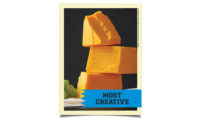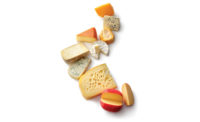Consumers love their cheese and are clear about what they want. It has to be easy to eat, portable, available in a variety of flavors and all-natural. These are the dominant themes from almost every cheese processor we spoke with. Convenience, flavor innovation, authenticity and freshness are key factors that will drive consumer cheese purchases, according to the Wisconsin Milk Marketing Board, Madison.
Milk | Cheese | Cultured | Ice Cream | Butter | Non-dairy Beverages | Ingredients | Exports
Cheese production increased to over 11.8 billion pounds in 2015 from 10.4 billion pounds in 2010, according to the USDA’s National Agricultural Statistics Service. (See the line graph)
The numbers tell the story
Based on sales and product innovation, consumers are choosing natural cheese over processed versions. The natural cheese category continues to grow, boosted by high household penetration and growing interest in natural cheese, which represents three quarters of total sales, according to a cheese report by Mintel, a Chicago-based research firm. Natural cheese category sales grew 24% from 2010-2015, reaching $23.2 billion in 2015. The processed cheese segment holds on to 18% of the market, although sales remain rather stagnant. From 2010-2015, the segment grew just 3%, reaching $4.2 billion in 2015.
Consumers remain interested in cheese for its wide variety of formats and flavors. Its appeal as a nutritious snack also helps as Americans snack more frequently, said Mintel. It predicts the natural cheese category will grow 19% from 2015-2020 to reach $27.7 billion, at current prices, and expects processed cheese to continue its decline slightly over time.
Information Resources Inc. (IRI), Chicago, reported that dollar sales rose 0.8% to $12.8 billion and unit sales increased 4.4% to 3.8 billion in the natural cheese category, for the 52 weeks ended Sept. 4, 2016. In contrast, the processed cheese category saw dollar sales drop 5.3% to $2.9 billion and unit sales decrease 6.3% to 780.3 million. (See the tables)
According to a survey from Yellow Door Creamery, a brand of Schuman Cheese, Fairfield, N.J., more than 80% of survey respondents eat cheese either every day or multiple times a week. And nearly 90% of respondents feel that cheese enhances the overall taste and presentation of a dish.
The U.S. Department of Agriculture said the average American consumes 34 pounds of cheese annually, a growth of 43% over the past 25 years. Americans consume on average 14 pounds per year of American cheese, up from 13.3 in 2010, and 21 pounds per year of all other forms of cheese, which is also up from 19.4 pounds in 2010, according to the USDA’s National Agricultural Statistics Service.
Snacking and hybrid products
As consumers seek out more protein, the snacking revolution has taken over the food industry, including cheese. Hybrid products are driving new innovation. Cheese is being paired with nuts, crackers, fresh fruit, dried fruits, lunch meat and pretzels in grab-and-go snack packs. Consumers are looking for bolder, flavorful snack options, said Barbara Gannon, vice president of corporate communications and community relations for Sargento Foods Inc., Plymouth, Wis.
Sargento added two varieties to its innovative Balanced Breaks line of cheese, dried fruit and nut snack packs. The new varieties are Colby-Jack cheese with sea-salted peanuts and blueberry juice-infused dried cranberries and Gouda cheese with honey-roasted peanuts and dried cranberries. The snack packs, which were introduced last year, have been the most successful product launch in the company’s history, said Gannon.
Dairy processors took full advantage of the snacking craze with a slew of new portable cheese products hitting stores.
New individually wrapped cheeses called Croc Bites were introduced from Old Croc, maker of Australian cheeses, which is distributed by Trugman-Nash LLC, Millburn, N.J. The cheese snacks are sold in 6-ounce bags with eight portions. A 0.75-ounce serving has 5 grams of protein. Jarlsberg Cheese, a brand of Norseland Inc., Darien, Conn., introduced Cheese Snacks, 0.75-ounce individually wrapped cheese sticks that are sold in an 8-pack. One cheese stick contains 70 calories, 6 grams of fat and 5 grams of protein.
The Laughing Cow, a brand of Chicago-based Bel Brands USA, launched Cheese Dippers, an on-the-go snack that features creamy Swiss cheese paired with crunchy breadsticks. One 1.23-ounce pack has 100 calories, 6 grams of fat and 4 grams of protein. Rochester, Minn.-based Reichel Foods, added four new varieties to its Pro2Snax line, a single-serve snack pack that features fresh produce paired with a healthy protein, like cheese. The new varieties include baby carrots with sriracha Jack Cheese; and sliced apples with mild Cheddar cheese, dried cranberries and cashews. The carrot and cheese variety contains 140 calories and 7 grams of protein per package.
Not just for kids anymore, fancy “lunchables” are being marketed to people of all ages. Chicago-based Hillshire Snacking created single-serve packages of natural cheese, salami and toasted crackers. These small plates come in four varieties, like Italian dry salami with Gouda cheese and wine infused salami with white Cheddar cheese. The wine-infused salami variety contains 16 grams of protein per package. Cady Creek Farms, Wilson, Wis., launched the Cheesewich, a cheese and meat snack in four varieties, like sliced hard salami sandwiched between two slices of mild Cheddar. The snack is sold in a ready-to-eat 2.5-ounce vacuum-sealed package. The Cheddar variety contains 16 grams of protein per serving.
For some processors, simply finding a new way to package its products has opened up new channels. Lincolnshire, Ill.-based Saputo Cheese USA launched a 3-pack of its Frigo Cheese Heads string cheese. The packs are available in regular, light and Colby Jack and are ideal for smaller store formats, like convenience stores. The company also introduced Frigo Cheese Heads cheese and meat combo packs. Varieties include string cheese and pepperoni and Colby Jack and turkey. They are sold in packs of eight.
Convenience rules
Cheesemakers answered the call for convenience in a big way. New formats that focus on portion control and ease-of-use are showing up in stores in abundance.
Chicago-based Dutch Farms’ Cracker Cuts cheeses are packaged in a re-sealable container. Each 10-ounce package contains 20 slices. Options are sharp Cheddar, marble Jack and pepper Jack. BelGioioso Cheese, Green Bay, Wis., introduced cheeses packaged for portion control in fontina and mozzarella varieties. Three pieces of cheese (totaling 0.75 ounces) are packaged in a bag (a serving contains 70 calories). The cheese is sold in an 8-pack.
Velveeta, a brand of Kraft Heinz, Chicago, aimed for convenience with its new 5-pack of 4-ounce individually wrapped cheese blocks. Ideal for portion control, a 1-ounce serving contains 70 calories and 4 grams of fat. Schuman Cheese introduced Yellow Door Creamery, a brand of specialty cheeses. The cheese is rBST-free and includes Brilliant Blue cheeses, which are sold as cubes in 5-ounce tubs and 2-packs of 2-ounce blue cheese portions.
Processors got innovative with new shakeable options as well. Simply Artisan Reserve, a brand of Litehouse Inc., Sandpoint, Idaho, introduced Simple Seasons, finely crumbled soft cheese in a convenient, shakeable glass jar. The cheese comes in blue cheese and feta varieties and is made with just five ingredients: milk, salt, culture, enzymes and an agent to prevent caking. Cabot Creamery, Waitsfield, Vt., introduced Cheddar Shake — a shelf-stable powdered premium Cheddar cheese in an 8-ounce plastic bottle. The cheese powder is ideal for pizza, salads and pasta.
Bold flavors are in demand
Flavor innovation is another way cheesemakers are expanding their audience and driving sales.
“Bold flavors are big in the specialty cheese category,” said Kareen Stephens, brand manager, Schuman Cheese. “Whether the boldness is from the cheese itself or from a spice addition, consumers are seeking out intense flavors.”
Schuman’s Yellow Door Creamery introduced a line of spice-rubbed fontina that includes harissa, Tuscan and habanero and lime spice blends.
Terry Brockman, president and COO of Saputo Cheese USA, said, “As consumer palates become more sophisticated, consumers are increasingly interested in cheeses with higher flavor profiles as well as new and unique flavor combinations.”
Saputo focused on unique flavors with launches in several of its brands. A three-pepper Colby Jack Wisconsin Snacking Cheese was added to the Frigo Cheese Heads line. Three-pepper features a combination of jalapeno, habanero and chipotle peppers. It’s sold in packs of 10. In its Black Creek brand the company added a Cheddar and merlot cold-pack cheese spread in an 8-ounce container. For its Great Midwest brand it introduced habanero Jack cheese, a semi-soft cheese that combines Monterey Jack cheese flavor and peppery habanero. It’s sold in 2- and 5-pound loaves.
BelGioioso Cheese combined convenience with flavor in its La Bottega di BelGioioso artisanal cheese line. The collection includes hand-wrapped 4-ounce cuts for easy tasting. The flavors are Crescenza-Stracchino, a tangy and spreadable cheese; American Grana; gorgonzola with cow and sheep’s milk; 24-month-aged Provolone Extra; and Peperoncino Asiago con chili pepper, which is said to have a spicy and savory flavor.
Sargento focused on putting “big flavor into a small bite” with its new Snack Bites line, the company said. The small sticks of natural cheese are sold in a 6-ounce resealable bag and come in four varieties, including savory garlic and herb Jack and Colby-pepper Jack. The company also expanded its sliced cheese line with two new varieties: tomato & basil Jack and garlic & herb Jack.
Educating on specialty cheeses
Consumers desire more information about cheese types, flavors and pairings, reported Mintel. In-store experiences could help to educate consumers. The opportunity to sample cheeses in the store would influence 70% of consumers to buy more cheese, according to its survey. And retailers that offer more than a transactional experience for purchasing cheese are likely to appeal to consumers. This may include offering samples, offering recommendations from store staff, or cheese pairing information, according to Mintel.
“Our greatest opportunity is to draw in the newest consumers to the category, millennials,” said Schuman Cheese’ Stephens. “As new, younger consumers gain interest in the specialty cheese category they are not necessarily shopping in the same way that current specialty cheese consumers are. They tend to be a bit more adventurous with their choices.”
Authenticity is very important to consumers when purchasing cheese, said Mintel. In its survey, two thirds of respondents indicated it is important that international cheeses, such as Italian, French or Mexican, are authentic. This view is slightly higher among millennials. Manufacturers of imported cheeses should emphasize the authenticity of their products. Locally produced cheeses are also important to consumers. Half of respondents wish there were more local cheese brands available at their store, while 48% agree locally made cheese is worth paying more for. Local cheeses are significantly more important to millennials.
Organic Valley, LaFarge, Wis., recently launched a specialty line called Kingdom — a premium organic Cheddar. It comes in three varieties: sharp, cracked black pepper and caramelized onion, and all imported from the United Kingdom. Saputo’s Stella brand introduced a premium organic 6-ounce wedge of Parmesan cheese and an organic shredded Parmesan in a 4-ounce cup.
Amy Woodbridge, senior brand manager of Castello, Basking Ridge, N.J., said, “The biggest opportunities for growth in the category are in expanding consumers’ eating occasions for specialty cheese products to include more everyday occasions.”
Castello, an Arla Foods brand, introduced its first Cheddar cheese to the U.S. market this year with new Extra Mature Cheddar chunks and burger Cheddar slices. The Extra Mature Cheddar is aged for at least six months and is said to have a sharp flavor with sweet and salty notes.
The growing consumption of cheese and the corresponding growth of the specialty cheese industry lend itself well to a growing interest in cheeseboards, added Woodbridge. Cheeseboard interest has increased in the United States during the last five years — 54% of the worldwide searches of the term “cheese board” come from the United States, according to the company. Castello’s new Cheese Board Builder, a first of its kind online tool, provides educational tools for consumers to learn how to match cheeses with wine, beer and other ingredients.
In summary, cheese remains a household staple and sales continue to grow as a result of the natural cheese segment, said Mintel. There is opportunity to promote the nutritional benefits of cheeses, as well as boost organic and better-for-you options, especially among parents. There is also a need to educate consumers about natural cheese types, flavor profiles and pairings in an effort to help them feel less overwhelmed about the category, Mintel noted. Overall, the future looks bright for cheese.
What’s the industry talking about?
- High-protein
- Convenience
- Snacking
- Grass-fed
- All-natural
- Clean ingredients
- Hybrid products
- Bold flavors
- Lactose-free
- Portion control
Milk | Cheese | Cultured | Ice Cream | Butter | Non-dairy Beverages | Ingredients | Exports













